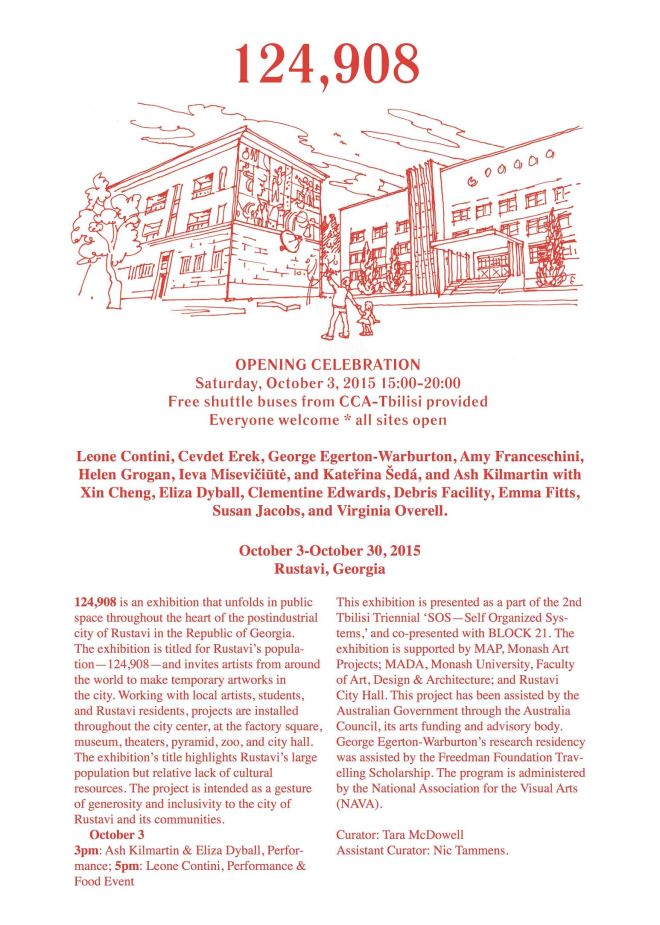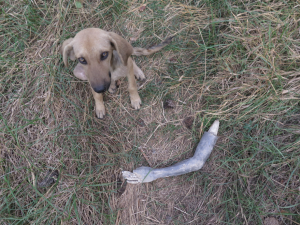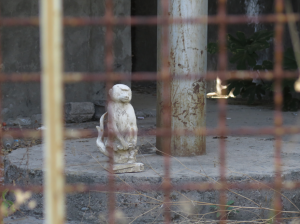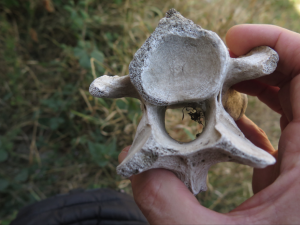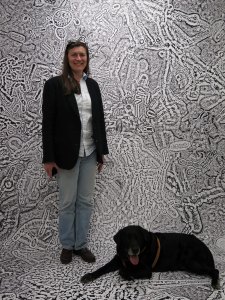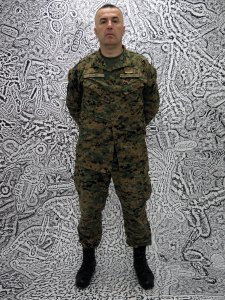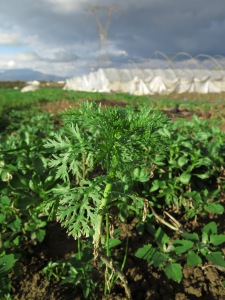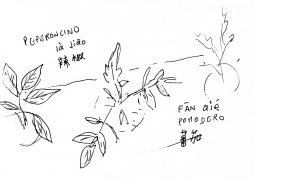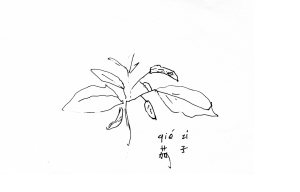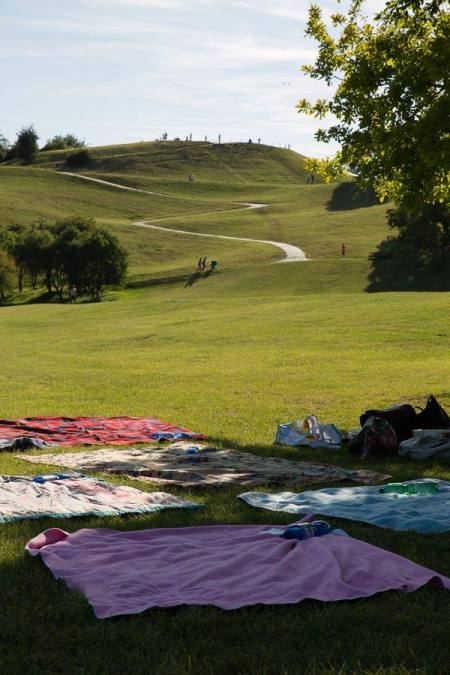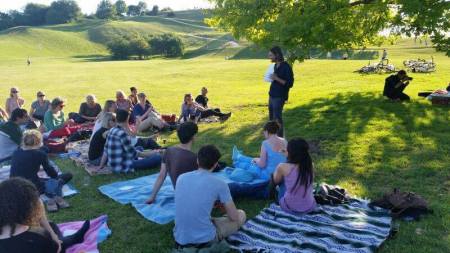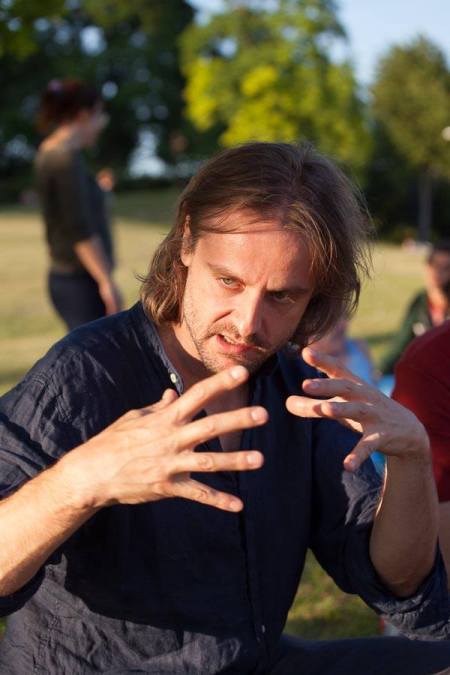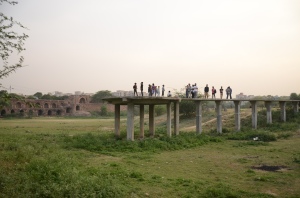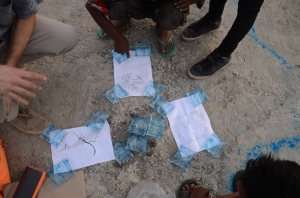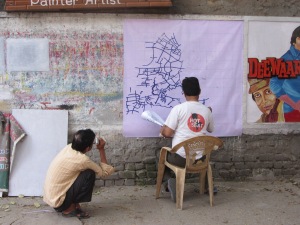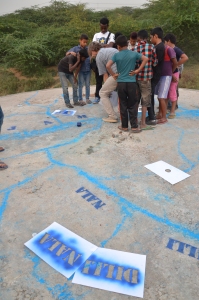Official website
December 10, 2022Il sole sorge ad Occidente
November 22, 2016124,908 – SOS – Self Organised Systems, the 2nd Tbilisi Triennial
October 2, 2015124,908
Leone Contini, Cevdet Erek, George Egerton-Warburton, Amy Franceschini, Helen Grogan, Ieva Misevičiūtė, Kateřina Šedá, and Ash Kilmartin with Xin Cheng, Eliza Dyball, Clementine Edwards, Debris Facility, Emma Fitts, Susan Jacobs, and Virginia Overell
An exhibition unfolding in public space around Rustavi, Georgia
Curated by Tara McDowell, part of SOS – Self Organised Systems, the 2nd Tbilisi Triennial
October 3 – October 30, 2015 Rustavi, Georgia
This exhibition is presented as a part of the 2nd Tbilisi Triennial ‘SOS—Self Organized Sys- tems,’ and co-presented with BLOCK 21. The exhibition is supported by MAP, Monash Art Projects; MADA, Monash University, Faculty of Art, Design & Architecture; and Rustavi
City Hall. This project has been assisted by the Australian Government through the Australia Council, its arts funding and advisory body. George Egerton-Warburton’s research residency was assisted by the Freedman Foundation Trav- elling Scholarship. The program is administered by the National Association for the Visual Arts (NAVA).
Curator: Tara McDowell Assistant Curator: Nic Tammens.
124,908 is an exhibition that unfolds in public space throughout the heart of the postindustrial city of Rustavi in the Republic of Georgia.
The exhibition is titled for Rustavi’s popula- tion—124,908—and invites artists from around the world to make temporary artworks in
the city. Working with local artists, students, and Rustavi residents, projects are installed throughout the city center, at the factory square, museum, theaters, pyramid, zoo, and city hall. The exhibition’s title highlights Rustavi’s large population but relative lack of cultural resources. The project is intended as a gesture of generosity and inclusivity to the city of Rustavi and its communities.
October 3
3pm: Ash Kilmartin & Eliza Dyball, Perfor- mance; 5pm: Leone Contini, Performance & Food Event.
Leone Contini, Freedom Zoo, images from field research:
Stirring the Pot of Story: Food, History, Memory
May 12, 2015Exhibition dates: 19/05 – 13/06
Opening times: Mon – Sat, 11:00 – 18:00
Venue: Delfina Foundation
Curated by: Nat Muller
Participating artists: Cooking Sections (UK), Leone Contini (IT), Mella Jaarsma (NL/IDN), Christine Mackey (IRL), Mounira Al Solh (LB/NL), Raul Ortega Ayala (MX).
Stirring the Pot of Story explores how power relations have shaped how and what we eat by looking at individual and collective memories of food in written and unwritten histories. The title is borrowed from J.R.R. Tolkien’s concept of the “Pot of Story”, the idea that story begets story. World events, issues of governance, class, identity, geography, nationhood, and gender are all brought to the boil in the cauldron of food politics.
The exhibition focuses on the direct link between power and the control of food. It rethinks narratives of the past such as colonialism, war and migration, and how these continue to inform our relationship to food in our current social and political contexts.
Dutch-Indonesian artist Mella Jaarsma looks at the colonial history of the Dutch tea trade in the East Indies. Lebanese artist Mounira Al Solh offers an intimate account of food, war and desire during the Lebanese civil war, while Irish artist Christine Mackey pays homage to an Irish pea that was repatriated from Russia back to Ireland.
In newly commissioned works Italian artist Leone Contini looks at the iconography of Italian food cans of WWI, and the London-based collective Cooking Sections research how the foodways of the British Empire resonate with mobility and bio-warfare today. Raul Ortega Ayala constructs a Tower of Babel of fat and bones, an apt metaphor for the ruin and decay of our times.
This exhibition is part of The Politics of Food (Season 2): Sex, Diet & Disaster.
http://delfinafoundation.com/whats-on/exhibition-stirring-in-the-pot-of-story-food-history-memory/
INHABITANTS – 3rd EDITION OF THE PROJECT BIENNIAL OF CONTEMPORARY ART D-0 ARK UNDERGROUND
April 19, 2015Inhabitants – Pilot study
The bunker, built during the cold war, is an enclosed world made out of concrete, aiming to create a barrier into the local ecosystem, hypothetically polluted by a future nuclear war.
Its relation with the outside is mediated by different kind of filters, to turn this environment into an ultimately self-sufficient world.
Inhabitants aims is to challenge this paranoid device, revealing that the bunker is not a sterile, nor isolated environment. On the contrary is inhabited by billions of primitive, microscopic live forms, mainly bacteria, whose existence extend the borders of life before us (and probably after us) for billion of years.
The project is a “pilot study” aiming to reveal how nature colonized, probably since the very beginning, this monument to human fear, to ironically defusing it in an ecological perspective, by restoring the continuity within the local ecosystem.
The study was carried in cooperation with the Department of Biology of the University of Rome.
Opening: Friday, 24th April 2015, 11am Atomic Shelter, Konjic, Bosnia and Herzegovina Participating Artists: Leone Contini (Florence), Dante Buu (Rožaj/Sarajevo), Documentary Embroidery (Vahida Ramujkić and Dejan Došljak/Belgrade), Effi & Amir (Brussels), Helidon Gjergji (New York/Tirana), G.R.A.M. (Graz), Tue Greenfort (Berlin), Wiebke Grösch / Frank Metzger (Frankfurt/Main), Flaka Haliti (Munich/Vienna), Marlene Hausegger (Vienna), Dritan Hyska (Tirana), Adela Jušić (Sarajevo), Johanna Kirsch (Vienna), Elvedin Klačar (Vienna/Sarajevo), Damian Le Bas (Worthing), Delaine Le Bas (Worthing), Ralo Mayer & Oliver Gemballa (Vienna/Hamburg), Anna McCarthy (Munich), Damir Očko (Zagreb), Nikolay Oleynikov (St. Petersburg), Alketa Ramaj (Tirana), (Belgrade), Selma Selman (Bihać), Mladen Stilinović (Zagreb), Sylvia Winkler / Stephan Köperl (Stuttgart). The Third edition of the Project Biennial of Contemporary Art will be organized in partnership with Republic of Albania and Republic of Austria. Curators of the 3rd edition of the Project Biennial are: Adela Demetja (Tirana Art Lab – Center for Contemporary Art) and Margarethe Makovec & Anton Lederer (<rotor> Center for Contemporary Art, Graz). The Project Biennial of Contemporary Art, D-0 ARK Underground is a unique project in the field of contemporary art, as it is located in one of the most fascinating underground military objects built during the period of the Socialist Federal Republic of Yugoslavia (construction period 1953-1979). Today, the atomic shelter in Konjic is kept and maintained by the Ministry of Defense B&H, but at the same time is listed as part of the national cultural heritage of Bosnia and Herzegovina. The final aim of the Project Biennial is the transformation of the Atomic Shelter into a hybrid Cold War-Art-Museum, unique in the world. The participating artists of the 3rd edition of the Biennial contribute site-specific or thematically related works, which redefine the contextual parameters of the reading and understanding of “Tito’s atomic shelter”. They comment on the formation of critical social discourses and alternative ways of life during the time of the Cold War and their effects on present-day contexts. ************************************************************* Opening: 24th April 2015, 11am Duration: 25th April – 24th October 2015 Opening hours/ Visitor information: Monday, Wednesday and Friday, at 10:00, 12:00 and 14:00 Visits should be arranged at least 7 days beforehand by contacting the e-mail address: bhbijenale@gmail.com For the opening weekend, additional visiting hours on Saturday, 25th April 2015 are: 10:00, 12:00 and 14:00 Location: Atomic Shelter, Konjic, Bosnia & Herzegovina Contact: Project Biennial of Contemporary Art D-0 ARK Underground http://www.bijenale.ba bhbijenale@gmail.com
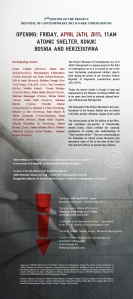
Riso, rape e vigneti – Per una prospettiva diversa sugli orti cinesi tra Prato e Firenze
April 7, 2015Mattina presto in un luogo imprecisato tra Firenze e Prato. Il signor X., un contadino originario della Contea di Wencheng, inizia la sua giornata di lavoro. Ha piovuto molto nei giorni scorsi e la terra è fradicia. Mi accorgo che una porzione del campo di forma allungata è completamente allagata, le vigne di sangiovese si riflettono in questa strada d’acqua bassa come in uno specchio. Qualche giorno fa il signor X. mi aveva detto, mentre spalava affondato nel fango, “riso va bene”. Ho pensato che ironizzasse sul fatto che solo del riso sarebbe potuto crescere in quel pantano. Sono anni che osservo il lavoro dei contadini wenzhounesi in questa parte di Toscana e ho imparato a riconoscere, nominare e cucinare decine di verdure. Quello che non riuscivo neanche a immaginare si è materializzato stamattina su un limpido letto d’acqua: piantine di riso. Una risiera perfetta, sotto il profilo orlato di cipressi delle colline toscane, a pochi metri da vigneti e oliveti. Quello che ieri era una concetto limite, quasi surrealista, oggi è realtà. Domani sarà cibo.
è bello essere qui a due passi dalla risaia, immerso nella serenità della campagna. sulla collina di fronte i vitigni stanno germogliando mentre il sovescio, che è cresciuto rigoglioso, aspetta di essere trebbiato e trasformato in concime biologico. Le radici profonde e salde del vigneto, quelle leggere delle piantine di riso che stanno attecchendo: se un alieno atterrasse oggi qui penserebbe che questo paesaggio agricolo è esistito da sempre.
Ma da una paio di settimane si è scatenata una violenta aggressione mediatica nei confronti degli orti cinesi. Il signor X. non può sospettarlo ma c’è un’arma puntata anche contro di lui, un contadino che passa le sue giornate a dissodare, riparare le serre distrutte dal vento, scavare solchi, concimare, far germinare semi in rudimentali incubatrici incubatrici per poi trapiantare i germogli tra le zolle argillose o nel limo soffice della risaia. La maggior parte degli ortaggi di cui si prende cura e che nomina in dialetto wenzhounese erano giù stati inseriti da Linneo nelle tassonomie universali nell’opera Species Plantarum, le fondamenta della moderna nomenclatura botanica. Ma per giornalisti e politici locali e per gli organi di controllo queste sono verdure dal “profilo genetico sconosciuto” e sui media si parla confusamente di inquinamento biologico o genetico, semi illeciti, importati clandestinamente dai migranti. La “corruzione del patrimonio locale” è una proiezione persecutoria che compie un giro completo incarnandosi nell’alimento alieno, e così le pratiche agricole dei cinesi vengono combattute con odio, come se minacciassero il corpo sociale. Dovrebbe essere un’ovvietà che i vegetali alimentari, addomesticati dall’uomo attraverso secoli di esperimenti e selezioni, non si propagano automaticamente negli ecosistemi, perché se così fosse vivremmo in un Eden di opulenza. Le innumerevoli varietà di Brassica Rapa che i contadini cinesi coltivano in toscana sono il frutto di un lavoro secolare, di migrazioni di uomini e materiale genetico, di intelligenza politica e di ingegneria agricola, di sapere medico, conoscenza e cura del corpo umano. Oggi noi temiamo questa ricchezza, come dei regrediti. E pensare che il mite Linneo aveva trovato un posto e un nome per tutti alcuni secoli fa, quando ancora l’Europa, salda nel proprio Sè, si credeva metro universale e padrona del mondo – Ma secoli dopo che in Cina quelle specie erano state sapientemente selezionate, oltre che nominate.
C’è però un dato epocale, così grande da essere difficilmente inquadrabile: i contadini cinesi hanno per la prima volta in un secolo invertito un processo che ha determinato la scomparsa del 70% della biodiversità in Toscana. Grazie a loro queste colline vedono nascere nuovi germogli dopo decenni di declino dell’agricoltura.
La neo-ruralità cinese non è un’agricoltura non del lusso e neppure del sussidio europeo, è più di un orto di sussistenza ma non è intensiva ed è anzi legata alla manualità, ma soprattutto è estranea al concetto di monocoltura. In un ettaro di orti cinesi è presente una varietà genetica impressionante.
Guardo i piloni dell’alta tensione, penso all’inceneritore e al nuovo aeroporto, per finire nelle vigne del contadino toscano, non quelle biologiche sulla collina, ma queste vicine alla risaia: sono legate a mano con i rami del salice secondo una sapienza antica, ma i loro tronchi si stagliano sull’erba arancione bruciata dal diserbante. Anche i canali di scolo sono irrorati di veleno. Tradizione, toscanità e violenza sull’ecosistema possono coabitare. Nel frattempo il signor X., con la sua zappa larga, diversa dalla nostra, sbarba una ad una le piante che infestano il suo curatissimo filare di quelle che in dialetto si chiamano Xian Gu Cai, una verdura già ampiamente coltivata da alcuni anni in Europa (specialmente in Spagna) e conosciuta internazionalmente con il nome cantonese di Bok Choy, e che Linneo nominò Brassica Rapa Chinensis.
Al Museo Pecci di Prato, ancora sulla verdura cinese a Km0:

Km0. Installazione, Museo Pecci, Prato 2012: https://www.youtube.com/watch?v=EsfvKRlU3Gs&feature=youtu.be
HIDDEN ECONOMIES: A SEMINAR ON ECONOMIC POSSIBILITY – The Royal Academy of Fine Art, Copenhagen, DK
October 21, 2014http://www.hiddeneconomies.net/main/
HIDDEN ECONOMIES: A SEMINAR ON ECONOMIC POSSIBILITY
Hidden Economies: A seminar on economic possibility raises a discussion about hidden economies–existing within, next to, beside, and around capitalism. The seminar is inspired by the work of feminist, economic geographers JK Gibson-Graham (Julie Graham and Katherine Gibson), who worked on several publications and projects that sought to destabilize the “monster” of a capitalist economy. Today, Katherine Gibson continues the work she and the late Julie Graham began with projects like Community Economies (co-founded in 2009) and the publication of Take Back the Economy: An Ethical Guide for Transforming Our Communities (2013, University of Minnesota Press).
Capitalist processes shape our daily experiences but do they define them? How and where are people creating economies that ignore the dominant economic system? How do these economies–shared, exchange based, micro-local, etc.–function and what do they look like? Are they temporary or are they sustainable?
Hidden Economies consists of presentations and workshops from artists, activists, and scholars focused on issues of economy within their work. The seminar focuses on how cultural work may contribute to shedding light on economic difference and articulating new economic realities. Central for this project is the idea that economies are always diverse and in the making.
Hidden Economies is extended through partnerships with three organizations: Pixelache–Finland, The Centre for Ecological Economics and Ethics–Norway, and Connectors Malmö/Tapori Tiffins–Malmö. These three organizations will host events to share the Hidden Economies newspaper and video program in Fall/Winter 2014-2015. The curated video program focuses on failed, lost, and new economies. The newspaper includes articles and images from seminar participants among others and will first be available during the seminar.
Seminar participants:
LEONE CONTINI (IT)
GEOFF COX (DK)
ANDREA CREUTZ (SE)
ESRA ERDEM (DE)
ANDREA FRANCKE (PE/UK)
MELISSA GORDON (UK)
ZEENATH HASAN (SE)
SUSAN JAHODA (US)
JAKOB JAKOBSEN (DK)
VLADAN JEREMIC (SRB)
SANDY KALTENBORN (KOTTI & CO.) (DE)
RENA RÄDLE (SRB)
RENEÉ RIDGWAY (NL)
MALIHA SAFRI (US)
MARINA VISHMIDT (UK)
ELIZABETH WARD (AUT/US)
CAROLINE WOOLARD (US)
FLORIAN WÜST (HABEN UND BRAUCHEN) (DE)
Imagined Menu at Kunstraum München
July 30, 2014 Imagined Menu by Italian artist Leone Contini arises from a historical event that happened in October 1917 with the worst defeat in the history of the Italian military: the “Rotta di Caporetto” (the Defeat of Caporetto). Between October and November about 300.000 Italian soldiers were taken prisoner and later on allocated to prison camps in Germany and Austro-Hungary; the status of the soldier suddenly changes: from being a fighting-machine he is turned into a defeated device, a prisoner of war. His body, which until that moment was fed by rations and canned food, now becomes drained and undernourished. One of the prisoners of Caporetto is Giosuè Fiorentino, a young Sicilian officer and great-uncle of Leone Contini, who was interned at Cellelager, north of Hannover, along with 3000 other Italian officers. The small community of his barrack – the barrack being the minimum social unit in the life of the camp – experiences hunger, cold and despair, but at the same time develops strategies of collective resistance. The prisoners contrast the “Sbobba”, the soup that barely keeps them alive in the camp, by sharing recipes and “memories“ of intensely desired food, which is also subject of endless discussions among them. The sharing of this “imagined” food is probably an attempt to cope with the extreme hunger, to redirect this basal instinct and convert a crowd of hungry bodies to something akin to a community. This conviviality – though virtual – is in itself an act of collective resistance. Giosuè Fiorentino wrote down in two hand-bound notebooks the recipes described by his fellow prisoners; the result is a vast mosaic of Italian regional cuisines at the time of 1900, about 250 recipes from Friuli to Sicily. B98, the identifier of his barrack, became also the title of one of the two cookbooks. Imagined Menu, after having been presented in 2013 by Kunstverein Amsterdam, arrives in Munich with two events: _ July 18, 2014 the Kunstraum München will present in cooperation with the Kunstverein Milano a lecture performance conceived as a flowing narrative that de-constructs the means for nutrition and control over the body of the soldiers during the Great War, from the trenches to the prison camps after the defeat of Caporetto. The “traces” produced during the lecture performance will remain on view until July 6. _ July 3, 2014 the recipes from the cookbook B98, imagined by Italian prisoners during the First World War, will be turned into real food in the form of a picnic on the Olympiaberg, the hill that was piled up from the debris of Munich generated by the bombings during the Second World War, today a leisure urban park. Each dish will be an opportunity for reflections and informal talks between the artist and his guests.
Imagined Menu by Italian artist Leone Contini arises from a historical event that happened in October 1917 with the worst defeat in the history of the Italian military: the “Rotta di Caporetto” (the Defeat of Caporetto). Between October and November about 300.000 Italian soldiers were taken prisoner and later on allocated to prison camps in Germany and Austro-Hungary; the status of the soldier suddenly changes: from being a fighting-machine he is turned into a defeated device, a prisoner of war. His body, which until that moment was fed by rations and canned food, now becomes drained and undernourished. One of the prisoners of Caporetto is Giosuè Fiorentino, a young Sicilian officer and great-uncle of Leone Contini, who was interned at Cellelager, north of Hannover, along with 3000 other Italian officers. The small community of his barrack – the barrack being the minimum social unit in the life of the camp – experiences hunger, cold and despair, but at the same time develops strategies of collective resistance. The prisoners contrast the “Sbobba”, the soup that barely keeps them alive in the camp, by sharing recipes and “memories“ of intensely desired food, which is also subject of endless discussions among them. The sharing of this “imagined” food is probably an attempt to cope with the extreme hunger, to redirect this basal instinct and convert a crowd of hungry bodies to something akin to a community. This conviviality – though virtual – is in itself an act of collective resistance. Giosuè Fiorentino wrote down in two hand-bound notebooks the recipes described by his fellow prisoners; the result is a vast mosaic of Italian regional cuisines at the time of 1900, about 250 recipes from Friuli to Sicily. B98, the identifier of his barrack, became also the title of one of the two cookbooks. Imagined Menu, after having been presented in 2013 by Kunstverein Amsterdam, arrives in Munich with two events: _ July 18, 2014 the Kunstraum München will present in cooperation with the Kunstverein Milano a lecture performance conceived as a flowing narrative that de-constructs the means for nutrition and control over the body of the soldiers during the Great War, from the trenches to the prison camps after the defeat of Caporetto. The “traces” produced during the lecture performance will remain on view until July 6. _ July 3, 2014 the recipes from the cookbook B98, imagined by Italian prisoners during the First World War, will be turned into real food in the form of a picnic on the Olympiaberg, the hill that was piled up from the debris of Munich generated by the bombings during the Second World War, today a leisure urban park. Each dish will be an opportunity for reflections and informal talks between the artist and his guests.
[a trümmerberg – see below – is this: http://en.wikipedia.org/wiki/Schuttberg]
Bottlegourd Bokchoy Ballet* – Khoj, New Delhi.
June 9, 2014My search started not far from Khoj, near the archaeological ruins of Satpula, a pre-Mogul dam. I was especially attracted by a drain, hidden from view – but not from olfaction – by an embankment. Although very polluted the place emanated some aura. I later realized that this water body is merely called “drain” on Google maps, nothing but an open sewer. Sewers don’t have names, don’t have past nor identity, and hopefully they are soon or late buried under the city. However it was a sewer with aura.
A down-stream journey brought me to the merging point of the drain and Yamuna. But my journey was also metaphorically up stream, in the denied past of the drain. Driven by Sohail Hasmi, I engaged into a sort of archaeology of naming processes regarding this drain, and possible counter-representations.
Chiragh-e-Dehli was the nikname of the Sufi Saint Sheikh Naseer-Ud-Din and so the stream associated with him was known as Chiragh Dehli Nala, though in colloquial Hindustani it became Chiragh Dilli or Chiragh Dilli Nala. The water of this stream was regarded as sacred both by Muslims and Hindus, it was collected in jars and considered having healing properties. The lost of its name, together with its historical and religious identity, is both connected with the eradication of the local Muslim population with the 1947 partition and with the subsequent chaotic growth of illegal colonies along the stream. But a vaster eradication is still in process, in the form of a “drainisation”, and therefore burial, of Delhi’s water catchments, including Chiragh Dilli Nala. And it looks like the invisibilisation-destruction of Delhi’s water system progressed so far to a very advanced stage. The merging point of Chirag Dilli Nala and Yamuna (or Jamna) is a beautiful but possibly very corrupted farming landscape, here I collected several vegetables, especially lauki or bottle gourd, that are very familiar to me, under the southern Italian dialectal name cucuzza. The vegetables looked nice but I was concerned with their possible invisible corruption: I sent them to a chemical laboratory in order to search for the possible presence of heavy metals.
But my up-stream khoj (“search”) brought me also in Majnu-Ka-Tilla, where water activist from Toxic Links carried a vast – and quite dramatic – survey on locally farmed vegetables. I spent a beautiful afternoon in the Tibetan refugee camp and its riverbank, where local peasants have being trained by Tibetans to farm Chinese vegetables, familiar to them (and to me), but named differently. The vegetable internationally known as bokchoy is here very popular, and is named pesa, while in my neighbourhood in Tuscany, Italy, is called xiang gu cai by Wenzhounese migrants. Uncontrolled denominations. In Majnu-Ka-Tilla this small vegetable means many things at the same time: an umbilical cordon with the lost motherland, a geopolitical paradox and a surreal genetic journey of Brassica Rapa Chinensis back to its roots. This vegetable is in fact the outcome of a secular process of domestication, started about 900 hundred years ago from the possibly native Indian Brassica Rapa, while the vegetable started a slow migration-transition from the Sub-Continent to China.
Like for the lauki I also checked the bokchoy, searching for the invisible poisons.
The result og the tests was made public in the opening day, during a tasting of Sicilian lauki and Tuscan-Chinese bokchoy recipes.
* a special thanks to Sidharth Srinivasan for suggesting me the title “Bottlegourd Bokchoy Ballet”
